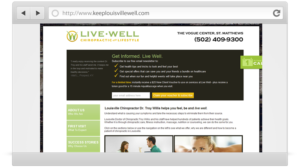Everybody wants their medical practice’s website to rank at the top of Google search results for their target keyword phrase. Dominating Google can get your medical, dental, or chiropractic in front of people who are actively looking for exactly what your business offers – something that print, radio and television advertisements are not as effective at doing. Simply put, a top-ranking website can be a business owner’s dream come true.
But most business owners don’t know much about search engine optimization. And getting to the top of Google search results is not a cinch. Depending on the competitiveness of a keyword phrase, it can take months (even years) for a site to climb to the top of the Google ladder.
Don’t let this reality distract you from taking action, though. If your website is new or just isn’t meeting your expectations, there are some simple and powerful things you can do in just fifteen minutes that will help make your medical practice website more search engine friendly.
So here’s the challenge I am issuing you right now: take fifteen minutes to do (or make sure you have done) these three things. After you do, come back and let us know how it went in the comments section below. And of course, if you have any questions, feel free to email me. I reply to every email.
Ready? Here, we go:
#1. Identify your primary target keyword phrase (time: 5 minutes)
Your primary target keyword phrase is the main phrase you will optimize your site for. It is the phrase that members of your target market will use the most to find products and services that businesses like yours offer.
Go to the Google Keyword Tool. It is completely free (Google is amazing). Type in possible primary keyword phrases. The chances are pretty good that your primary keyword phrase is “[Your city name] [Your specialty].” For example, if you are a pediatrician practicing in Denver, it is probably “Denver Pediatrician.” Nevertheless, give it a go and search a variety of options before you make a decision.
While using the Google Keyword Tool, pay special attention to the “Local Monthly Searches” column of data (obviously, the more traffic a keyword phrase has, the more weight you should assign to it). Once you locate a keyword phrase that you think is a good fit, tattoo it in your brain; you’ll use it for parts two and three of this challenge.
#2. List your business and website on key directories (time: 7 minutes)
Backlinks (links from other websites that point to your website) are strong indicators of a website’s authority. Google loves authoritative websites and rewards them with top spots. There are hundreds of directory websites out there that can help you build backlinks. But we only have fifteen minutes. To get the highest return on your time, make sure your medical practice is listed on the websites that seem to have the highest search engine klout:
- Google Plus Local (formerly Google Places) – list your medical practice on Google Plus Local
- Yelp – list your medical practice on Yelp
- CitySearch
CitySearch is peculiar. As of writing this post, they don’t have an easy way to create a business profile on their website. But I have a temporary solution: email them your business information at myaccount@citygridmedia.com. I did this just a day ago for a client and CitySearch got back to me that very same day. I know, it is a bit of a hassle, but it is worth the extra effort.
When listing your business on these sites, make sure that your business name, address, website and telephone number are written exactly the same. Also, in places where it makes sense to do so (like in Category or Description sections), include the target keyword phrase you identified in step 1.
#3. Include your primary keyword phrase in the title, header and alt tags on your homepage (time: 3 minutes)
I have risked dropping too much SEO jargon on you by casually mentioning title, header and alt tags, which might cause you to exceed the 15 minute milestone. If you are unfamiliar with these, you can quickly learn what they are here, here and here.
Search engines like Google have bots that crawl and index websites. These pieces of software look for title, header and alt tags to see what the website is about. Think of these tags as little website clues Google seeks out when forming an opinion on websites.
I’ll explain this to-do with a handy example of how this is done correctly. Live Well Chiropractic and Lifestyle is a new Chiropractic practice in Louisville, Kentucky. If you visit this practice’s homepage, you will see that the title and header tags contain “Louisville Chiropractor” – their primary keyword phrase. The same phrase is wisely included in the first image’s alt tag.
Here is a screenshot of the homepage that I have referred to for your visual enjoyment:
So there you go: three easy things you can do to help your medical practice’s website get found on search engines.
Now, go out there and knock them out today!
If you have any questions, comments or tips, please share them by commenting below!
About Matt Langan:
Matt Langan is a Co-Founder of CadenceMed, a company that improves patient relationships by optimizing the look, feel and functionality of a medical practice’s online presence.


